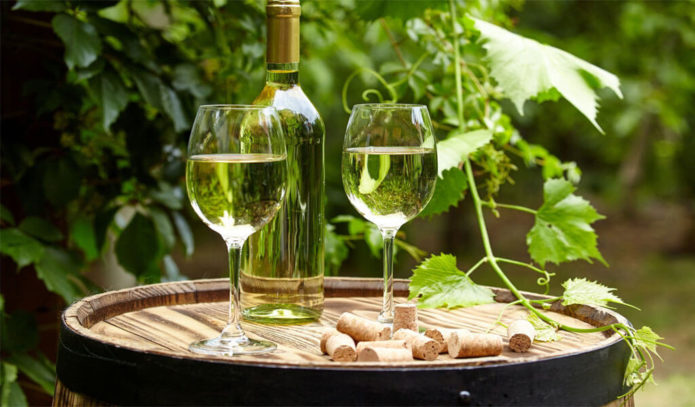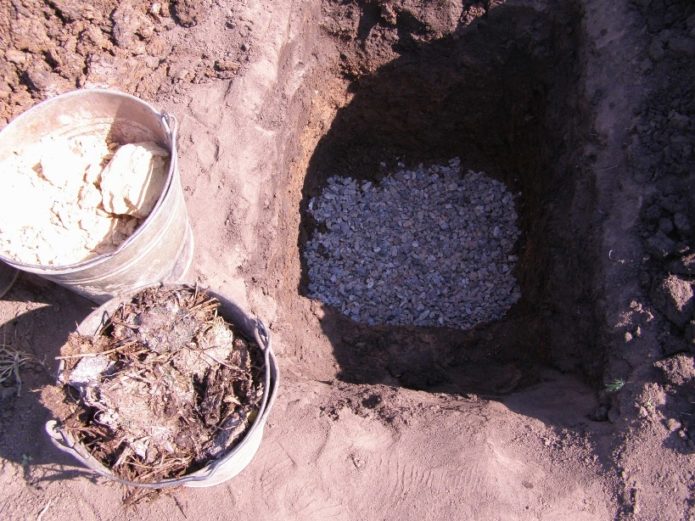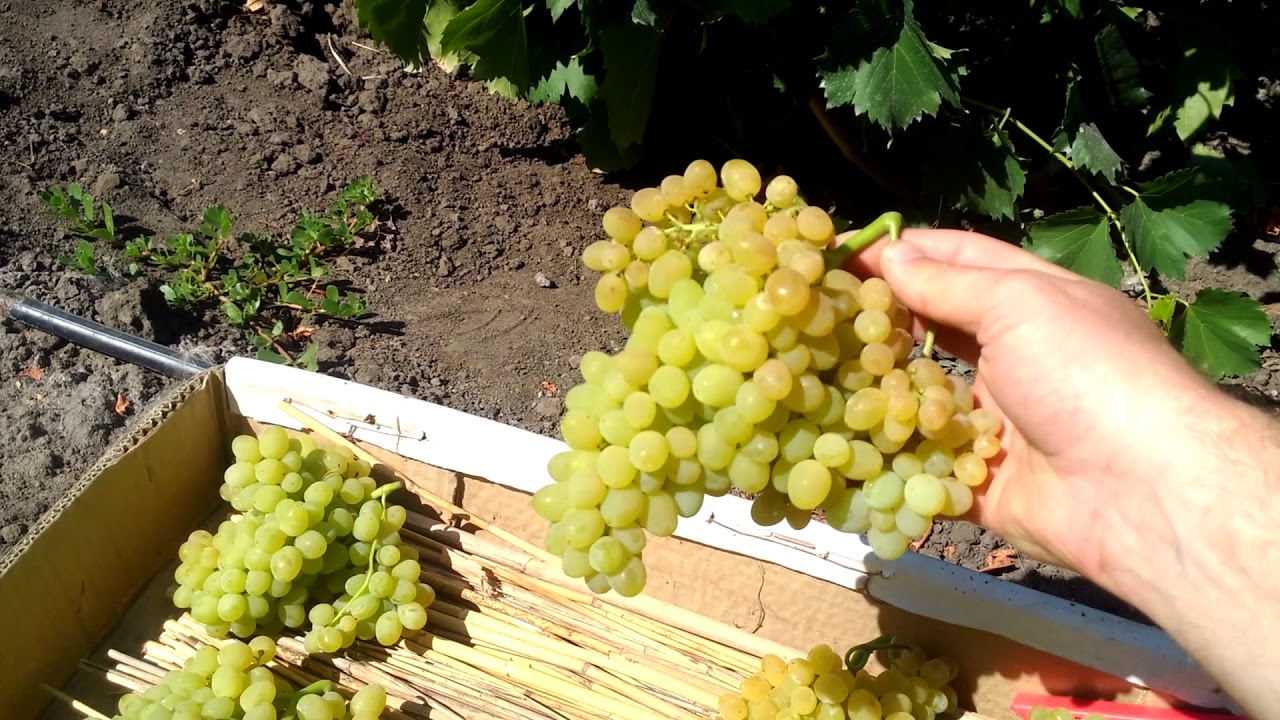For many years, grapes were considered an exclusively southern culture. But today it is successfully grown in regions with a temperate climate. Breeders have bred many varieties that can produce a bountiful harvest of delicious berries in difficult weather conditions. These include the Crystal grape, which has gained well-deserved popularity among northern winegrowers, due to its unpretentiousness and high winter hardiness.
Content
Breeding history and description of Crystal grapes
The Crystal grape was born in Hungary, by pollination of a hybrid of Amur and Challozi Loios with pollen of the Villard Blanc variety. It was entered into the Russian Register of Breeding Achievements in 2002. The State Variety Commission recommended Crystal for cultivation only in the North Caucasian region of our country, but the experience of many winegrowers shows that it feels great in more northern regions, provided it is sheltered for the winter.
Kristall is one of the earliest technical grape varieties. It reaches technical ripeness within 110–120 days after the start of the growing season. In the south of our country, harvesting of this variety begins in mid-August. In the middle lane and more northern regions, the ripening period of Crystal grapes usually falls in the first half of September.
Kristall bushes are medium-sized. Their shoots are colored in a characteristic yellowish-brown color with a slight burgundy tint and are distinguished by good ripening. Leaves are medium in size, dark green, heavily cut. The flowers are bisexual, due to which the Crystal does not need the presence of the pollinator variety.
Berries of the Kristall variety are medium-sized, oval, in a ripe state they have a greenish-yellow color with a pronounced prune bloom. They are collected in conical clusters of medium density, weighing 170-200 g, which do not crumble when overripe. The average yield of the variety is 160 kg / ha, the maximum is 200 kg / ha.
The flesh of the Crystal berries is juicy, with a simple but harmonious taste. It contains 17-18% sugars with an acidity of 5-7 g / l. The skin is quite dense.
Features and conditions for growing grape varieties for wine production:https://flowers.bigbadmole.com/en/yagody/vinograd/sorta-vinograda-dlya-vina.html
In industrial cultivation, Crystal berries are most often used as raw materials for making white dry wines such as sherry. Private growers make various types of wine from them, including by blending with other grape varieties. But the range of applications for the Crystal berries is not limited to winemaking. They make tasty compotes, juices and other processed products. Not spoiled by delicious grapes, gardeners of the northern regions often use Crystal for fresh consumption.

The tasting score of table wine made from Crystal berries is 8.5 points, and sparkling wine - 9.1 points
Crystal berries are not prone to cracking when excessive moisture is present. They keep well on the bush for a long time after ripening. At the same time, they gain the maximum amount of sugar, losing acidity, which greatly simplifies the taste of the wine made from them.
According to the State Register, Crystal can withstand temperatures as low as -35 ° C. Other sources speak of winter hardiness at -29 ° C. This variety also possesses high resistance to such common fungal diseases as:
- mildew (2 points);
- oidium (2.5 points);
- gray rot.
To determine the resistance of grapes to common diseases, it is customary to use a five-point system, in which 0 points denotes the presence of complete immunity, and 5 points - the strongest susceptibility to infection.
The crystal is often attacked by wasps and birds. They love to feast on its sweet and juicy berries, competing for the harvest with the grower.
In order for the fight against diseases and pests of grapes to be most effective, you need to be able to recognize the symptoms and correctly select the necessary treatments:https://flowers.bigbadmole.com/en/yagody/vinograd/bolezni-vinograda-opisanie-s-fotografiyami-i-sposobyi-lecheniya.html
Video: overview of the Crystal variety
Growing features
Compared to other grape varieties, Kristall does not differ in high demands on growing conditions. Nevertheless, caring for it has a number of features that the vineyard who planted it needs to know about. Compliance with the recommendations for the care of this variety will help to get a bountiful harvest even in regions with a cool climate, not included in the zone of traditional viticulture.
Reproduction and planting
The first step towards obtaining a bountiful harvest of Crystal grapes is a competent choice of planting material. It is better to buy it in large garden centers and nurseries. Buying seedlings at markets or fairs often turns out to be the purchase of an unknown plant instead of the desired variety, which does not always turn out to be grapes. This is especially true for varieties that are in high demand, including Kristall.
Well-developed roots are the main feature of a quality seedling.... At least three of them must be over 10 cm in length and over 3 mm in diameter. Healthy roots are greenish brown on the outside and white on the inside.
If you have a choice, you should give preference to seedlings with a closed root system. They tolerate transplantation better and take root in a new place faster.
The Kristall variety is distinguished by its good ability to quickly root, therefore, you can prepare planting material yourself by cutting off a stalk from an adult bush. For the appearance of roots, it is placed in a container with water or any moist substrate with a volume of 1–1.5 liters, which is left in a warm place. The optimum temperature for future seedlings is 25–27 ° C. Under favorable circumstances, the roots are formed in 2-4 weeks. After their length reaches 3 cm, the young plant is transplanted into the ground.
Some growers successfully propagate the Crystal with air layers.... In this case, the root system is formed at the lignified shoot, without prior separation from the bush. The process of obtaining an air layer begins in early spring, during intensive sap flow. It includes several stages:
- A well-developed shoot is selected in the vine and stripped of leaves.
- At a distance of about 20 cm from its apex, an annular bark incision is made with a width of no more than 5 mm.
- Wrap the incision with wet moss, which is secured with black foil. Moss can be replaced with a container with light soil.
- In autumn, shoots with a formed root system are separated from the vine and planted in small pots, which are removed for wintering in a cool place.
Video: separation from the main vine of the air layer of Crystal grapes
To plant the Crystal, choose a well-lit and draft-protected place. The southern slope of a gentle hill is ideal for it. You should not choose lowlands for growing grapes, where melt water and cold humid air stagnate for a long time. Planting in such areas often leads to the development of root rot and plant death. Crystal does not tolerate a high level of groundwater, which is also capable of causing fungal diseases of the underground part of the plant.
The distance between the Kristall bushes should not be less than 75–80 cm, and between the rows - 2.5 m. Such scheme of planting grape seedlings allows you to use the land plot as efficiently as possible, providing each plant with the necessary nutritional area and a sufficient amount of sunlight.
Crystal is planted in open ground in spring or autumn. In the northern regions, growers often use spring planting. It allows young plants to root well and stock up on nutrients before the onset of cold weather.
When planting in spring, the pit is prepared in the fall. At its bottom, drainage from small pebbles must be laid. It will protect the plant from stagnant water that is harmful to the roots. Then the hole is filled with fertile soil, into which you can add a few spoons of complex fertilizer or two to three liters of woody vines. Sometimes a pipe is installed at the bottom of the pit, through which the grapes are subsequently watered.
They start planting after the ground warms up to 15 ° C. During it, the seedling is placed on the bottom of the pit at an angle of 45 ° and carefully covered with earth, preventing the root collar from burrowing. It should be located 3-4 cm above the ground surface.
Watering
The crystal tolerates a lack of moisture worse than other grape varieties. In arid regions, it is watered once every 10-15 days. In the middle lane and other regions of our country with a large amount of precipitation, 2-3 waterings per season are enough for Kristall. Excess water is just as bad for the grapes as lack of water. It often causes cracking of berries and the appearance of fungal diseases. To prevent damage to the harvest, watering of grapes is stopped 10–20 days before the fruit ripens.
Crystal, like other grape varieties, reacts negatively to moisture ingress on the fruits and green parts of the plant. Therefore, it is better to water it through special pipes installed during planting. If they are absent, several holes are dug around the perimeter of the trunk circle, which are filled with water during irrigation.
Disease and pest control
Compared to other grape varieties, Kristall is highly resistant to fungal diseases. However, in regions with a high prevalence of such infections, it needs preventive treatments. Usually they are carried out at least twice a season:
- immediately after the plant leaves wintering;
- during the opening of the leaves.
To combat fungal infections, drugs with fungicidal properties are used. These include:
- Horus;
- Topaz;
- Speed;
- copper sulfate;
- bordeaux liquid.
The best way to protect the Crystal berries from birds and wasps is to use a fine mesh net. It is used to cover the entire plant or to sew small bags that are worn over ripening clusters. Setting up traps will also help get rid of wasps. You can make them with your own hands by hanging a container filled with honey or jam diluted with water next to the grape bushes.
Pruning and preparing for wintering
For abundant fruiting of Crystal grapes, regular pruning is a prerequisite. Due to the thickening of the crown, shedding of ovaries often occurs, which leads to a decrease in the number of berries on a bunch and, as a result, a significant decrease in yield. Crystal shows the best results when pruning fruit vines for 3-4 eyes.In this case, the total load on the bush should not exceed 60 shoots.
Video: how to properly prune an adult grape bush
In the south of our country, Crystal does not need any special measures before the onset of cold weather. It perfectly tolerates the warm winters of this region, even if left on the trellis. But some growers still advise to carefully mulch the trunk circle with humus to prevent frostbite of the roots.
In central Russia, the Crystal must be removed from the trellises for the winter and laid down for the winter. After the establishment of a snow cover over the vine, a snowdrift is formed. Its safety is carefully monitored throughout the winter, regularly breaking the crust and, if necessary, updating the entire structure. In regions with a high risk of a very cold winter with little snow, the Crystal removed from the trellises is additionally covered with spruce branches, burlap or other material that allows oxygen to pass through well.
Plants under three years old require special preparation for wintering. It is better to cover them entirely by erecting a hut above them from burlap stretched over the frame. For insulation, you can also use cardboard boxes of suitable size filled with sawdust, paper or rotted straw.
Caring for grapes in the new season begins with the correct extraction of the vine from under the winter shelter:https://flowers.bigbadmole.com/en/yagody/vinograd/kogda-raskryivat-vinograd-vesnoy-posle-zimnih-ukryitiy.html
Advantages and disadvantages of the variety
| Advantages | disadvantages |
| High winter hardiness | Simple taste |
| Resistance to fungal diseases | Small size and nondescript appearance of berries |
| Good taste of wines made from Kristall berries | Fairly dense skin that feels good when eaten |
| Fast rooting of cuttings | The tendency to shedding the ovaries when the crown thickens |
| Very early ripening | Rapid loss of acidity during overripe berries, which leads to a deterioration in the taste of the wine made from them |
| Unpretentiousness | |
Winegrowers' reviews about Crystal
The crystal on my site is one of the earliest and sweetest varieties, and since it is also resistant to diseases and pests, has a decent winter hardiness, it is only by these parameters that you can keep yourself. This season, only prof. Naturally, he did not feed, did not normalize, he easily pulled out a pair of brushes on the shoot, the total collection from two three-year-old bushes (but planted with a two-year-old) was about 15 liters. Ripened for a week next to the growing Platovsky, accumulated more sugars, hung ripe without loss of quality for almost two months - the 9-year-old granddaughter who was visiting was eating them every day. Naturally, there was nothing left for juice, especially for wine. The impressions from the variety are the most positive.
This year I had a signaling cluster on the Crystal. It ripened unevenly, but for lack of another, I constantly tasted it. Finally, the cluster became yellow, beautiful. Sugar up to 23 Brix, but the skin spoiled the all-herbaceous aftertaste. Disappointed ...
I have Crystal for the sixth year now, I am satisfied with it, it is fruitful, early, it picks up sugar well, it is resistant to diseases, you don't need to cover it in the conditions of the Moscow region, but just in case I put it on the ground and winters under the snow.
Indeed, the variety has many advantages, but there is one significant disadvantage - the variety quickly loses acid during the ripening process. This is a problem for the winemaker, because the wine is getting flat, so I removed it from my mix.
Crystal is my first grape.
A strain that forgives beginners' mistakes. A variety that will allow you to enjoy the first bunches, without studying the treatment schemes for diseases.
The taste of ripe Crystal berries will give odds to many table varieties, which often do not gain phenolic maturity.
In my conditions, by September 20, Crystal is gaining a stable 18Brix.And if you want to touch winemaking, it is doubly pleasant to understand that you are dealing with a real techie.
This, I'm not afraid of this word, a masterpiece of Hungarian selection deservedly occupies the top position in the ranking of varieties for Northern winemaking.
The Kristall variety is ideal for northern viticulture. He is able to bring a bountiful harvest even in difficult climatic conditions of temperate latitudes, without requiring complex care. Of course, Crystal is inferior to many thermophilic grape varieties in taste. But in central Russia and in more northern regions, it has practically no competitors. Here it is used for making wine, juices and other processed products, as well as for fresh food.







